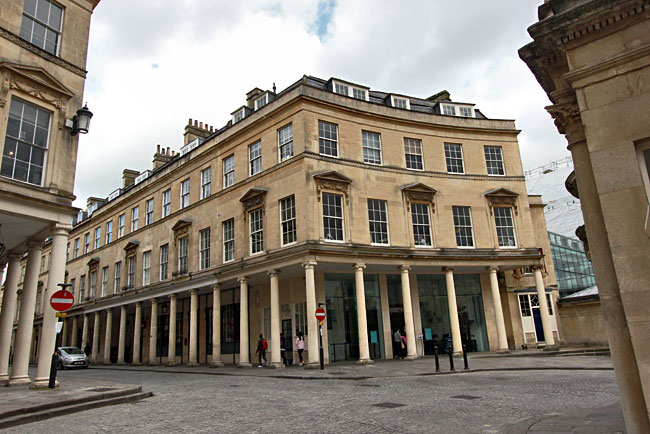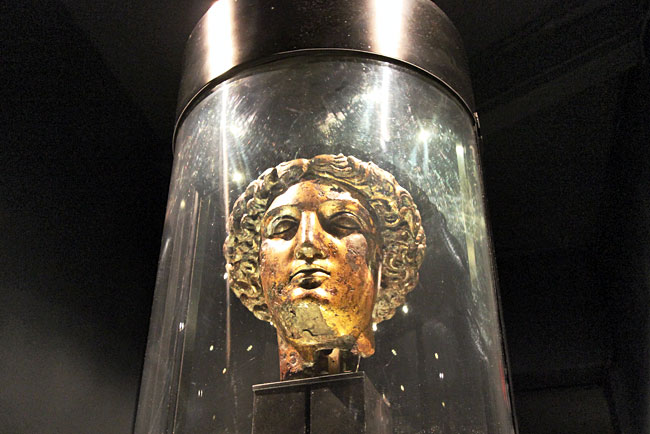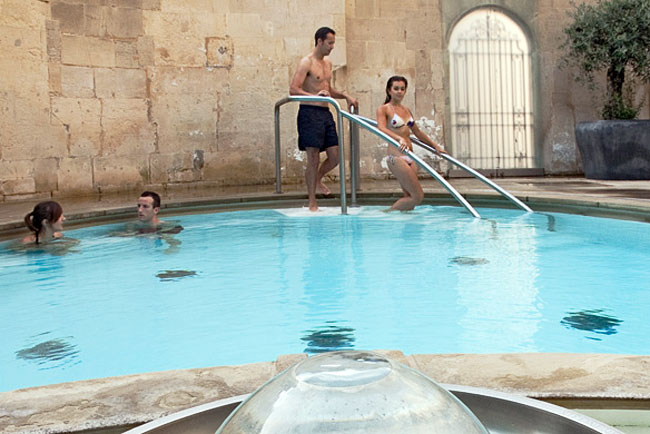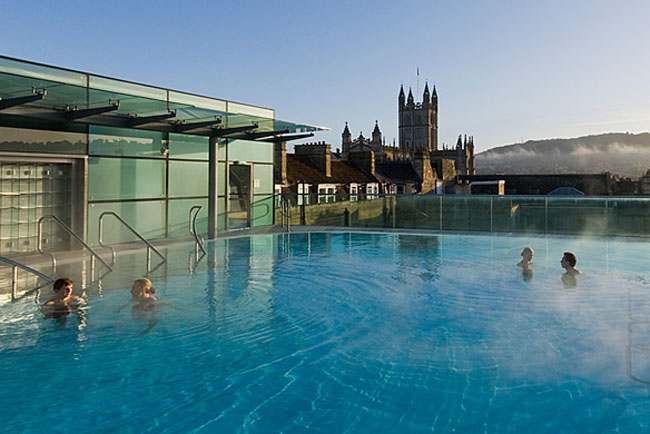From my vantage point at the rooftop pool at Thermae Bath Spa, I gazed down on row after row of Tudor and Georgian rooftops. I drank in the historic site as Charlotte Hanna, assistant sales & marketing manager for this famous spa in Bath, England, enlightened me about the history of hot springs in Bath. Archeological evidence suggests that humans were visiting and worshiping here as far back as 8000 B.C., but it wasn’t until 2,000 years ago, when the Romans colonized Britain, that written documentation began. The invaders wrote of a lush, uninhabited valley where natural hot springs bubbled up from the ground. Locals lived in forts atop the seven hills that surround the valley, descending each day to graze their livestock, fish, and to worship the water. But each night they retreated to their hilltop abodes, leaving the pristine valley to Sul, the pagan goddess of water, healing, and wisdom worshiped by Britons. “Clearly, the ancient people of Britain considered this a spiritual site,” Charlotte explained.

The Romans erected a temple to Minerva, their own goddess of wisdom and healing, but acknowledged the pagan goddess by naming the site Aquae Sulis, which means waters of Sul. By the first century AD they had constructed the Roman Baths, a five-foot deep rectangular basin lined with 45 sheets of lead and topped by an enormous barrel-vaulted hall. People from all over the Roman empire flocked to the the site: Germans, Italians, the Gauls (French), Spanish, northern Africans, some as slaves but many as travelers determined to visit what had by then become one of the most important destinations in the Roman empire.
Some 300-400 years later the Romans left as their empire began to collapse, ushering in an era of tribal battles, with Saxons and Vikings who fought over the territory. During that time, Bath crumbled. The beautiful old Roman buildings collapsed and the ruins were covered in silt by river flooding. By the time Britain emerged from the Dark Ages, Bath was just a small market town. That modest status did not change until the 16th century, when Queen Elizabeth I visited and gave the waters to the city, allowing Bath, rather than the monarchy, to benefit financially from the waters.

Word of the hot springs gradually spread across Europe but the biggest boon came in the 17th century when Mary of Modena, wife of James II, was unable to produce an heir. Her doctors recommended a trip to Bath. She took their advice and within a year gave birth to a healthy boy. Charlotte chuckled at this point and added, “As a quick aside, I’m told that the King had Syphilis, therefore the chances of the boy being his are remote. So she did a very good Catholic duty and produced a son and heir, but it wasn’t actually a son and heir.” Meanwhile, William and Mary from the Netherlands arrived to rule Britain; the bastard heir never sat upon the throne but the legend of Bath’s miracle waters spread far and wide.
By the 18th century everyone was “taking the water,” which meant drinking it. Soon, however, it became fashionable to immerse in mineral rich waters. Bath was the preferred place to do so because it is the only location in Britain where hot water flows out of the ground. Gradually the city was rebuilt. Most of the stately mansions in the city center, built of a local sandstone that shines golden in the setting sun, date to that 18th century building boom. It wasn’t long before the hot springs began attracting royalty, noblemen and the very wealthy. They demanded better facilities than the small market town offered, and the era of spas in Bath began.

Why these hot waters well up in Bath still remains something of a mystery. The area is not volcanic in nature; there are no plate tectonics at work. The geology is like a twisted sheet of paper that has opened cracks in the rock, allowing groundwater to seep far down into the earth. Heated by the molten core, pressure builds up and forces the water back to the top. Because the geology is so complicated around Bath, over the past twenty years geologists have sent heat-sensing probes down but they are always lost before they can find the source of Bath’s three springs.
Today, the ancient and modern hot springs and spas in Bath are among the most visited sites in the UK. A minimum of two hours are needed to properly tour the ancient Roman Baths, a UNESCO World Heritage Site that has extensive displays of items found during the archeological excavation. In addition to the Great Bath and the Sacred Spring, where 115 degree water bubbles up at a rate of more than 300,000 gallons each day, visitors can see the remarkable gilt bronze head of the goddess Minerva from the Temple of Sulis Minerva, as well as a portion of the original Temple pediment, which features a puzzling Gorgon head with snakes winding through its beard.

At the end of the Roman Bath tour visitors are invited to “take the waters.” I drank a glass of the vile tasting stuff on the off chance that the legend was true, but to actually bathe in the waters I had to visit Thermae Bath Spa. Earlier, Charlotte had explained that there are actually three springs. The ancient Roman Baths are built over one and a second is hidden beneath a sewer cover in the middle of a side street. A third is the source of the water for the Thermae spa in Bath. It wells up in the Cross Bath, smallest of the thermal baths, which is available for exclusive use by up to 12 people. Though it appears modern, beneath the floor lies an 18th century bathing pool and, in the far corner, an old Roman well. This place where ancient Britons worshiped the goddess Sul has been acknowledged as an official sacred site and regular ceremonies are still conducted to bless the water.

The spring water is also pumped to the spa’s open-air roof top pool and their indoor Minerva Bath. I chose to spend the majority of my time in the latter, following a blissful deep-tissue massage that used coconut oil and warm bamboo sticks to release muscles perpetually knotted from carrying a backpack crammed with 25 pounds of electronic equipment. I laid back in the warm water, closed my eyes, and let the gentle current carry me wherever it wanted. Every so often I paddled into the whirlpool and let the jets work on my shoulders and lower back. I even made an occasional foray into Aromatherapy steam rooms infused with aromatic essences such as lotus flower or eucalyptus mint. Though I was invited to eat in the on-site Springs Café & Restaurant, I simply could not tear myself away long enough to do so.

Charlotte and I had discussed the belief that mineral baths have curative properties.“There’s really no way to know,” she said, using the example of a lord, who in years past would spend his days hunting on horseback, drinking wine, and eating a diet heavy in fatty meat. “Once a year he would visit the baths for an extended time, where he would drink lots of water, get plenty of exercise, and eat healthy foods. His health would miraculously improve, but was it the water or the healthier lifestyle?”
The Roman Baths and ruins beneath the floor at Thermae Bath Spa are almost inconceivably ancient. They existed before Stonehenge or the Pyramids and scientists know from the amount of mineral content that the water is more than 8,000 years old. Who knows what secret cures they may hold? What I do know is that I felt better. It may have had something to do with the 92 degree temperature of the water or the 40+ minerals it contains, but I cannot remember the last time I was so relaxed. I have visited thermal baths that spew from the base of an active volcano in Banos, Ecuador; soaked in Banjar hot springs in Bali; and taken the waters at Warm Mineral Springs in Florida. Afterward, I always feel refreshed and renewed. I’m inclined to believe that those ancient Britons and Romans, who were so much more connected to and in touch with the land than we are, knew something that we don’t.

What to See and Where to Stay in Bath, England
For complete information about visiting the historic town of Bath, including attractions, events, accommodations, and dining, check out VisitBath.co.uk, the official tourism website for Bath, England. In addition to the Royal bath and Thermae Bath Spa, I enjoyed visiting the exquisite Bath Abbey, Fashion Museum, the Museum of East Asian Art, the historic Assembly Rooms, the Pump Room Restaurant, the Royal Crescent, Pulteney Bridge, Queen Square, Parade Gardens, Royal Victoria Park, and The Circus.
I took a three-day side trip to Bath, which was easily reached by train from my base in Bristol, England, and stayed at Brooks Bed and Breakfast. The B&B was a bit outside of the main town, requiring a 15-minute walk to the historic center, but it served one of the best breakfasts I’ve ever had.
Thermae Bath Spa offers two-hour ($39.50), four-hour ($55) or full day ($85) spa sessions, each of which provides access the open-air rooftop pool, Minerva Bath, aroma steam rooms, and the Springs Café & Restaurant. Towels, robes and slippers are not included in the cost of a spa session. You are welcome to bring your own or hire them from the main reception. All treatments and spa packages include complimentary use of towel, robe and slippers. To learn more about their facilities, services, and prices visit their website, www.thermaebathspa.com.
To learn more about opening times, events, and prices for the Roman Baths, visit their website, www.romanbaths.co.uk.
Disclosure: I was a guest of the VisitBath.co.uk and Thermae Bath Spa during my stay, however, the receipt and acceptance of complimentary items or services will never influence the content, topics, or posts in this blog. I write the truth, the whole truth, and nothing but the truth.

Those baths look wonderful and must be a refreshing treat for sight seeing tourists. I’m glad to learn the history behind them.
This looks so dreamy! It caught my eye because I’m planning a road trip throughout England and this may just be added to one of the destinations! Thanks for all the history and info. 🙂
enjoying your world and work, and pics, Measha is wonderful, we are very proud of her. Yes, England is so full of delights, if one reveres history, architecture, photography, archeology, etc…….never get enough.
Thanks Trixie. I’d never heard of her before but was so impressed with her voice and ability to convey what the songs were about through her body movements and facial expressions that I just HAD to interview her.
I remember relaxing in those aromatic steam rooms at the Thermae spa – and the Roman Baths is a realy outstanding place to visit – pity one can’t jump in the baths there too. I’d far rather swim in the water than drink it.
Me too, Heather. Can’t say I felt any effects from the glass I drank, but bathing in the waters certainly made me feel fantastic.
The Pictures are Very Nice. The Minerva Bath Pic is Awesome.
Very good description, I have never been in Europe I am planning a trip by the end of the year. I live in Costa Rica and my english is not the best, I really like the way you write very professional.
Thanks for sharing 🙂
Pura vida
My fave UK city. Besides the baths themselves, I love the Georgian architecture, especially Royal Crescent and The Circus where such luminaries as the inventor of shorthand, Pittman and explorer David Livingstone lived. Bath Abbey houses the tomb of Governor Phillip who was the first to rule Australia after European settlement in 1788. Beautifully written article bringing back some treasured memories.
Always makes me smile when a “foreigner” reveals things about my own country I didn’t know! Although I knew something of the history of Bath I’ve never been there…..must put that right some! Enjoyed reading this so much!
Thanks Linda. I loved Bath (could you tell?) and hope to go back one day. I was pampered and spoiled for an entire day at Thermae Bath Spa and would do it all again in a heartbeat. In fact, I’m in love with all of England, I think.
I understood the water was heated by passing over limestone … same principle as the ‘heat packs’ with which American soldiers heat up their field rations. Did you get to visit Sally Lunn’s and try one of the excellent buns while you were in Bath?
Hi Keith: I did go to Sally Lunn’s and had the bun. It was good, but pricey, and not a lot in the way of vegetarian options for me. But, that’s something I struggle with all the time.
Great post! Bath is a place in England that I really really like and enjoy going back to. I guess It mostly has to do with its Roman heritage but the town is also pretty gorgeous 😉
Hi Patricia: I agree, the town is absolutely gorgeous. When the setting sun hits those golden sandstone buildings they all light up like bright orange flames. Stunning.
Looks like a nice way to spend an evening! I am still slightly surprised by the amount of Roman history that you can find in Brittain. I really need to visit Bath, I am again so close, as I am in the Cotswolds.
Hi Jarmo: I’ve also been surprised by the amount of Roman history in England. A archeologist friend took me on a walking tour of York, and told me about all the layers beneath my feet, right down to the Roman remnants, and then showed me the few remaining ruins above ground. Amazing to think just how far the Roman Empire extended.